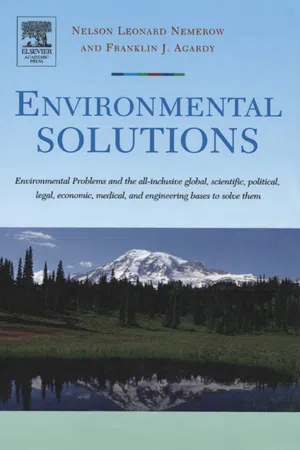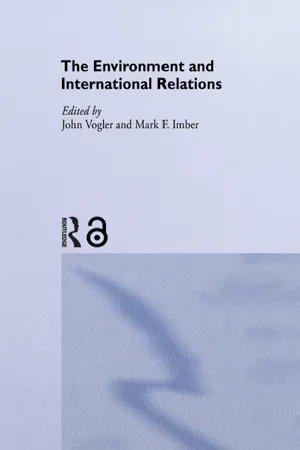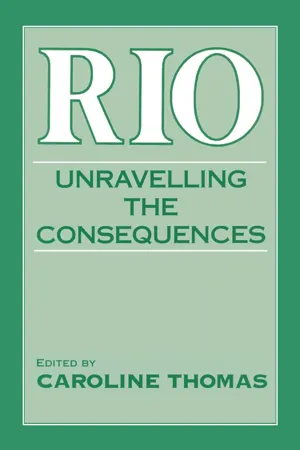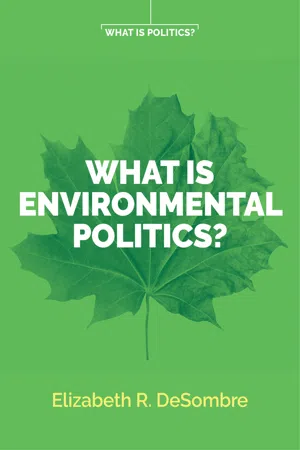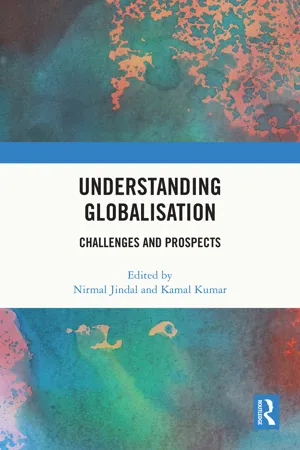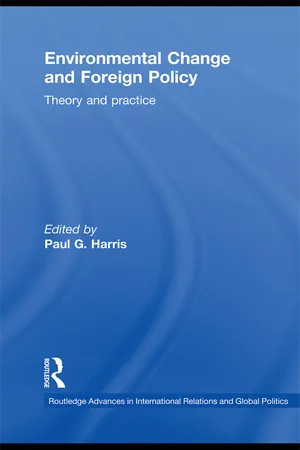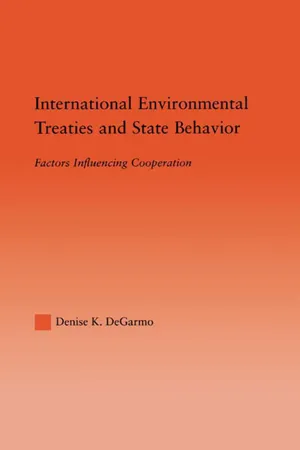Politics & International Relations
Debate on Environmental Issues
The debate on environmental issues encompasses discussions and disagreements surrounding policies, regulations, and actions aimed at addressing environmental challenges such as climate change, pollution, and conservation. Key points of contention often revolve around the balance between economic interests and environmental protection, the role of government intervention, and the allocation of responsibility among nations for global environmental issues.
Written by Perlego with AI-assistance
Related key terms
Related key terms
1 of 4
Related key terms
1 of 3
11 Key excerpts on "Debate on Environmental Issues"
- eBook - ePub
Environmental Solutions
Environmental Problems and the All-inclusive global, scientific, political, legal, economic, medical, and engineering bases to solve them
- Franklin J. Agardy, Nelson Leonard Nemerow(Authors)
- 2010(Publication Date)
- Academic Press(Publisher)
Issues related to global warming or climate change are good examples of where debates can occur at the international level under the sponsorship of organizations like the UN or at the local town or city level. Trying to develop a global framework and greenhouse gas target will likely be debated at the appropriate international forums. Statements in favor of one approach or the other could come from local resolutions sent to the larger international forums as well as local contributions toward solutions (a town energy ordinance or a state-level renewable fuel portfolio are examples of more local policies). Here you have a large-scale environmental problem that can have solutions or actions at the international and local levels.The debates over these different aspects of an environmental issue take place in many different forums. It is important to understand what forum you are in and what format the decisions are being made or codified. The basic formats include: government budgets, where funding can be allocated for a solution; laws passed at local, state, and national levels; regulations or guidelines that provide the road maps for implementing laws, and agreements between parties from interstate agreements to international treaties.Part of the dynamics of politics includes understanding how policy implications can change over time. We like to think there is a solution for any environmental problem, and that is generally true. What changes over time can be society’s values concerning how much risk is acceptable, our understanding of technology and our ability to continually innovate less costly solutions or our understanding of the environmental problem, and the nature of the impact. All of these factors play a role and influence the many different interest groups - eBook - ePub
- Mark Imber, John Vogler, Mark Imber, John Vogler(Authors)
- 2005(Publication Date)
- Routledge(Publisher)
fait accompli . The misrecognition of environmental concerns is now remedied through an approach which attempts to bring the environment into international relations. Such an approach is inherently limited, however, because it fails to account for the previous exclusion. Studying the political economy of the environment necessitates an attempt to understand why environmental issues had been hitherto neglected. That is, a past failure to include environmental concerns in the discipline cannot simply be regarded as a fact with no implications for the theorisation of the global system. Accelerated environmental degradation raises crucial questions concerning humanity’s relationship with the natural world, and with other species. Analyses of the global ecological crisis therefore require a rethinking of fundamental concepts and assumptions. Unless international relations theory sets out explicitly to tackle the set of questions which arise from the interaction between the economy and the ecosystem, it will instead merely find itself co-opting environmental analysis and accommodating ‘green’ issues within the prevailing conception of international relations. It is not in fact the case that international relations theory had previously ignored environmental issues altogether, but rather that (like all social sciences) by internalising environmental issues, it had rendered them invisible. International relations theory had traditionally removed from critical view the ways in which, historically, environmental issues had been silenced.The crucial question now becomes: how is the new-found visibility to be articulated? And it is important, indeed, to recognise which approaches will provide the best starting point for assessing the politics and economics of global environmental degradation. Before examining the contribution of IPE, it is necessary to look at the manner in which conventional international-relations theory has approached this task of assessment. - eBook - ePub
Rio
Unravelling the Consequences
- Caroline Thomas(Author)
- 2014(Publication Date)
- Routledge(Publisher)
In the academic world this problem is exactly the reason why the environment tends to be studied within a pluralist framework. The need for, and problems of, managing co-operation is the starting point for academic discussions of environmental politics, whereas in the political world the tendency is to see one version of environmental politics as being so compelling as to override national differences. This conflict becomes particularly problematic when the environment is an issue between less developed and richer states. In short, to speak of the environment and of the need to prevent its degradation is merely to specify yet another issue for the agenda of international politics, one which will not replace the existing mechanisms of inter-state relations, and not transcend the states-system by refocusing attention on an issue that is in some way ‘beyond’ or ‘above’ international politics. No such transcendental imperative follows from a concern with the environment, whatever the scientific consensus or environmental activists think. Maybe there should be, but that reflects a specific view of the salience of the environment in comparison to other issues and needs.My second point builds on this argument and is that if the environment is just one issue amongst many others in international politics, then it will be subject to exactly the same structural influences and processes as apply in other areas. The fact that the issue concerns the environment will not alter the mechanisms of international politics, however much the need for new mechanisms might be obvious to activists and academics alike. The history of the states-system’s ability to cope with other issues of world significance, notably nuclear and biological weapons, and famine, does not augur well. In short, maybe the environment is simply the latest in a series of issues, with no more likelihood of transcending the limitations of the states-system than its historical precedents. Of course, this does not mean that the environment must be peripheral per se - eBook - ePub
- Elizabeth R. DeSombre(Author)
- 2020(Publication Date)
- Polity(Publisher)
CHAPTER 5International Environmental PoliticsEnvironmental politics at the international level is different from local or national environmental politics in important ways. At the domestic level, governments make rules that bind their citizens. Though those citizens may play a role in advocating for or against those rules, they can be held accountable for upholding them, even if they would prefer not to. At the international level there is no overarching authority that can create rules for states (which is the term that refers to what is colloquially known as “countries”) or require that they be followed. Any rules that bind states internationally must be made by those states. That dramatically changes the extent and type of international policy and the politics of addressing environmental problems internationally.The complexity of international negotiation includes a context in which negotiators are concerned with both their domestic populations and the other states with which they are negotiating. States negotiating internationally also face a trade-off between stricter rules that bind fewer states (those willing to take on strong regulation) and weaker rules to which more states agree. Once any international agreements are reached, implementation, compliance, and enforcement are also more difficult than in the domestic context.As a result of the process that creates them, international rules are fragmented, diffuse, and overlapping, involving the creation of multiple treaties and institutions to manage them, and are often weaker than domestic rules. There are hundreds of international agreements addressing environmental problems. In part because of the complexity of creating binding international rules, other forms of international governance help address environmental issues. Non-state actors may work across borders to influence the behavior of actors in non-regulatory ways. - eBook - ePub
Understanding Globalisation
Challenges and Prospects
- Nirmal Jindal, Kamal Kumar, Nirmal Jindal, Kamal Kumar(Authors)
- 2023(Publication Date)
- Routledge India(Publisher)
Paris Climate Agreement among others. At the same time, governments of most of the developed and developing countries have shown considerable enthusiasm towards the needs of preservation and improvement of the human environment in recent decades. However, the governments’ enthusiasm was confined to making further announcements of environmental policies, international and national agreements, and legislations, and they have failed to bring any major changes as it comes in contradiction with their neo-liberal development policies. The agenda of economic development is still dominating the governmental discourse at both domestic and global levels. This chapter presents an overview of the major global environmental issues with a special reference to global warming, reduction of biodiversity, and resource scarcity. It also examines the global responses to tackle these issues. However, before doing so, it is pertinent to understand the reasons for labelling the environmental issues as “global”, and the factors contributing to the emergence and evolution of global environmental politics.Why Are Environmental Issues Global?
The term “global environmental issues” refers to a wide range of ecological issues and problems having a global scope and nature, though some of the issues pose more serious threats to certain countries but even they cannot be tackled locally without the support of global community and organisations. Owen Greene (2008) identifies four major reasons to explain why environmental issues are being labelled as “global” or “international”. First, some of the ecological issues are primarily global in their nature and scope. For instance, the emission of greenhouse gases (GHGs) such as carbon dioxide (CO2 ) and methane in the atmosphere increases the temperature of not just a place where these gases are emitted but simply increases heat around the world. That is probably why environmental issues require collective efforts from all the countries to address them. Second, many environmental problems are the result of mismanagement and overexploitation of “global commons” (Greene 2008 - eBook - ePub
- Gary C Bryner(Author)
- 2015(Publication Date)
- Routledge(Publisher)
NDERSTANDING GLOBAL ENVIRONMENTAL POLITICS Theories of International Relations and Political ScienceT here is broad and deep agreement among environmental scientists that climate change, water shortages, and loss of biodiversity combine with other global environmental problems to threaten the future of humankind. They point out that droughts and other extreme weather events, declining fisheries, emerging diseases, and inadequate food production are some of the results of these crises. The evidence of environmental harms is clear, and there is widespread consensus among ecologists that risks are increasing. Yet that scientific knowledge has not resulted in thorough policy responses. This chapter examines the political and behavioral factors that have kept us from developing effective responses to global environmental threats. This means asking why we have been so unwilling to address threats to our well-being, especially as taking timely action seems so clearly in our self-interest.One way to think about these challenges is to lay them out on a continuum. At one end are environmental consequences that can be managed under existing institutions of government; the task at this end is to continue with existing efforts and expand these efforts incrementally to meet new problems. International relations (IR) theories are best suited to address these kinds of consequences, but unfortunately, there is little agreement that consequences will be so limited. At the midpoint in the continuum are consequences that require major changes in the policy-making capacity. These involve creating the ability to bring about needed changes in the way people in the wealthy world consume resources and to foster a type of development in poor countries that dramatically increases their peoples’ well-being without also increasing their environmental impacts. At the other end of the continuum, environmental changes are likely to be chaotic, unpredictable, and catastrophic. IR theory is not well suited to suggesting how far-reaching changes in policy capacity can be fostered, and it has few resources for understanding human behavior in the face of catastrophic environmental change. - eBook - ePub
- Paul G. Harris, Paul G. Harris(Authors)
- 2009(Publication Date)
- Routledge(Publisher)
To be sure, this is a lot to digest, which is one reason why we might have to bite it off in smaller pieces – something that theory can help us do (see Part I and especially Chapter 2). Foreign policy objectives, actors and processes can be central in determining whether countries cooperate to address environmental problems. What is particularly important about foreign policy for our understanding of environmental policy within and among states is that it involves the crossover and interaction between domestic politics and processes, on the one hand, and international relations and institutions (“global politics”), on the other. Looking at purely local or international variables seldom explains environmental policies and agreements. Indeed, environmental issues are often distinctive in the manner in which they ignore state borders; problems in one country affect other countries, and problems restricted to one country often require the involvement of other countries (e.g., through financial assistance and technology transfer) if they are to be resolved or remain local. Many issues, actors and forces acting domestically and internationally affect and influence countries’ national environmental regulations and their environmental foreign policies, and hence they impact international environmental cooperation. Yet, despite obvious (albeit not fully comprehended) connections between local and international policy processes, many studies of environmental policy do not adequately account for the foreign policy aspects of environmental protection efforts, and frequently ignore foreign policy altogether. Many environmental policy officials are simultaneously pressured to follow international norms and promote national interests and ideals. That is, they are buffeted by domestic and international forces - eBook - ePub
Breaking Out of the Green House
Indian Leadership in Times of Environmental Change
- Dhanasree Jayaram(Author)
- 2012(Publication Date)
- KW Publishers(Publisher)
While looking at environmental issues from a global perspective, the role of international institutions in global environmental governance is eminent. It is a fact that inter-governmental organisations such as the United Nations Framework Convention on Climate Change (UNFCCC), the Inter-governmental Panel on Climate Change (IPCC) and others have been formed under the aegis of the UN; there are regional organisations that have also been making efforts in the areas of adaptation to and mitigation of climate change. Yet, these organisations have proven to be more or less incompetent in dealing with the multifarious, interdependent and political nature of environmental problems. This will be dealt with in the next chapter. The creation of networks of governance has definitely added another layer to global environmental governance, but still the nation states have monopoly over these international institutions. Interests of the States overrule the needs of global environmental governance. Even the Rio Declaration of 1992 plainly defends state sovereignty over natural resources in the Preamble. Neither have certain States relented to the core tenets of the Kyoto Protocol for different reasons. Besides, UN Environmental Programme (UNEP) set up by a resolution of the General Assembly does not have any executive powers; its objectives are completely dependent on persuasive powers. The current governance on global environmental issues is flawed as an enforcement body is absent.The Interactions and Counter-interactions in a World of Multiple Relationships The Prospects for Environmentalism and Diffusion of Governance in a Liberal DemocracyAs one talks about democratisation of institutions by increasing public participation, one also needs to closely analyse the persisting view that maintains that sustainability could be achieved though democratisation. This implies that somewhere down the line, democracy facilitates and probably enhances protection of environment. In fact, principle 10 of the Rio Declaration states that ‘environmental issues are best handled with the participation of all concerned citizens, at all relevant level’.13Environmental politics is one of those rare domains in which the policy-making has indeed witnessed wider participation from the civil society, especially the ENGOs. The role of the ENGOs assumes greater significance in a liberal democracy as they ‘identify risks, assess environmental impacts and design and implement measures to deal with them, and maintain the high degree of public and political interest required as a basis for action’.14 However, the ENGOs have also faced criticism from various quarters on two grounds – first, the ability of the ENGOs in influencing the promotion of environmental sustainability might be overstated though they provide for popular participation, and second, the democratic nature of the ENGOs has been viewed by many with scepticism primarily because of the fact that with increasing institutionalisation of these ENGOs, the participatory tradition is giving way for a more elitist or hierarchical tradition. The activities of the ENGOs are multifaceted—first, they might take on the role of agents of policy-makers by carrying out the task of implementing the policy-makers’ agenda in the society. This activity is also aided by the Government through funds; second, the ENGOs could take the views of the citizens of the society to the policy-makers, thus representing either their supporter base or the general public, and third, the ENGOs also play an important role in terms of transforming the behaviour and attitudes of the citizens towards environment. In this regard, besides engaging themselves in creating publicity for their cause and galvanising communities or even joining hands with the existing communities in order to manage local environment, the ENGOs have also begun to promote non-governmental environmental governance by mobilising support for their visible objectives and indirectly influencing the government policy. As James Rosenau said, “It is possible to conceive of governance without government—of regulatory mechanisms in a sphere of activity which function effectively even though they are not endowed with formal authority.”15 - Denise DeGarmo(Author)
- 2013(Publication Date)
- Routledge(Publisher)
83 is one way in which international relations and the international environment may be more easily studied.According to this view, international politics is understood as a “socially constructed institution that varies across space and time, with multiple meanings and practices that are not set in stone.”84 Environmental problems are believed to be influenced by not only the technological instruments through which information is produced and disseminated, but also by the institutional venue in which problems and solutions are debated and decided.85 In other words, different people and groups construct their understanding of the global environment and the implications of environmental changes and processes in different ways. This in turn leads to different assumptions and perceptions of environmental needs and different understandings of global ecological interdependence.86 These competing processes of construction are mediated by a host of social, political and economic institutions.Three models for the resolution of international environmental problems emerge from the social construction framework. The first model, known as global managerialism, proposes that international environmental solutions not only require strong central protection of environments around the world, but the division of labor between governments and international organizations, with NGOs performing an advisory role on the side. International environmental protection, then, would be best achieved through world conservation and global environmental services. The second model, known as redistributive development, pays greater attention toward equity issues. According to this model, past global inequities and the future of environmentally sound development in the developing world requires the “North” to increase financial and technological assistance to the “South.” Finally, the international sustainability model promotes the adoption of global sustainable development practices in the environmental, economic, and social realms to ensure the preservation of the international environment and the continuation of environmentally sound development into the future.87- eBook - ePub
Maintaining a Satisfactory Environment
An Agenda For International Environmental Policy
- Nordal Åkerman(Author)
- 2019(Publication Date)
- Routledge(Publisher)
This critique is based on a narrow concept of foreign policy according to which foreign policy pursues its goals to a large part by means of threat and force. Such an understanding does not reflect the relationship between intricately interlocked political units characteristic of foreign policy today. Particularly, it does not correspond with the form and challenges of foreign environmental policy. As outlined above, environmental affairs are, in essence, system affairs where reciprocal relationships dominate, at least in the long run. Consequently, foreign environmental policy reflects in particular the fact of reciprocal relationships among participants of the political process. Along with this feature, it clearly favors peaceful, cooperative methods and structures.To the extent that environmental affairs become an issue in foreign policy, this political pattern of pursuing cooperative, peaceful methods influences the general nature of foreign policy. Reciprocal problem structures as found in the field of environmental policy are also found to an increasing extent in other fields. Therefore, environmental policy can be seen as an indicator of, and as a means of changing the nature of foreign policy, that is, changing it from a policy which is characterized by confrontation, power and force to a policy which focuses on common needs and interests in a peaceful manner.International Environmental Mediation
Mediation can be defined as a process in which the parties of a dispute attempt to reach a mutually agreeable solution under the aegis of a third party reasoning through their differences (Dryzek and Hunter 1987: 89). International environmental mediation is then conceivable as a means of handling transboundary environmental problems where contradictory positions of the participants exist. Here, as in other fields, mediation can be construed as a device for settling a dispute or a means for resolving the problems facing the parties of that dispute. In the first case, only a very limited truce between "adversaries" is what mediation effects; in the second case, mediation leads to measures which prevent the reproduction of the environmental problem itself. - eBook - ePub
Environmental Justice
Issues, Policies, and Solutions
- Bunyan Bryant, Bunyan Bryant(Authors)
- 2013(Publication Date)
- Island Press(Publisher)
The second, or situational, dimension of environmental issues concerns the fact that these issues invariably involve concerns and material interests that are extra-environmental or non-environmental in nature. In other words, environmental issues and conflicts tend to be shaped in highly situational and contingent ways. Virtually every environmental policy issue is nested within other social issues, interests, and motivations. International environmental issues, in particular, are typically characterized by the superimposition of environmental motives and claims upon longstanding political, economic, and social struggles and policy questions (e.g., who benefits from development programs? Is colonization of frontiers by poor people desirable or undesirable? Can or should the planet feed several billion more human residents? Is rural-to-urban migration desirable? Is a raw-materials-export-oriented development policy a viable strategy to achieve Third World modernization?). Thus, while environmental issues as a whole cannot be tied in any universal way to the interests and concerns of particular social groups, most concrete environmental issues will involve clear-cut distributional implications and specific material interests. Various groups support or oppose environmental policies because of how these policies would affect their incomes and profits, economic security, property values, workplace safety, and public health (what Sunderlin, 1992, has called “instrumental environmentalism”). This means that over the long term, successful environmental mobilization will require coalition partners—in other words, non-environmentalist allies who support environmental protection because it will generally benefit the allies in concrete ways. At the same time, environmentalists can be sure that a broad agenda of environmental conservation will attract an array of opponents.Recognizing these organizing dilemmas, environmental movements have continually been compelled to seek out new ways of packaging their agendas and claims that, they hope, would be persuasive and effective. Well before the rise of global environmental change, these strategies tended to be based on globally oriented scientific reasoning (and ethical-moral appeals), because of the advantages such reasoning affords in dealing with the difficulties of environmental mobilization (ubiquity, multiple forums, the need for scientific legitimacy). Historically, these have included “the population bomb” (a notion from population biology and demography codified in popular terms by Ehrlich in 1968); the “limits to growth” (a notion from the systems dynamics school of operations research engineering, codified in popular terms by Meadows et al., 1972); and now “global environmental change” and “global warming” (originally codified by a range of scientist-environmentalists, especially Schneider, 1976; Myers and Myers, 1982; and WCED, 1987). Each was a comprehensive, essentially global, framework that justified the need for a global approach to more comprehensive environmental protection. Each did so by forecasting global disruption, predicting that if environmental conservation at a global scale was neglected, the future of humanity and the biosphere would be in peril. From each of these scientific-ideological vantage points, a strong case was made for concerted international responses; in so doing, the multiple forums of environmental problems can be dealt with because global agreements and regulations will override politics as usual on national and local levels. It merits mention, however, that each of the previous global formulas was ultimately de-legitimated to such a degree that the environmental community had to largely abandon the approach and look for a new one (Buttel et al., 1990; Taylor and Buttel, 1992).
Index pages curate the most relevant extracts from our library of academic textbooks. They’ve been created using an in-house natural language model (NLM), each adding context and meaning to key research topics.
Explore more topic indexes
Explore more topic indexes
1 of 6
Explore more topic indexes
1 of 4
